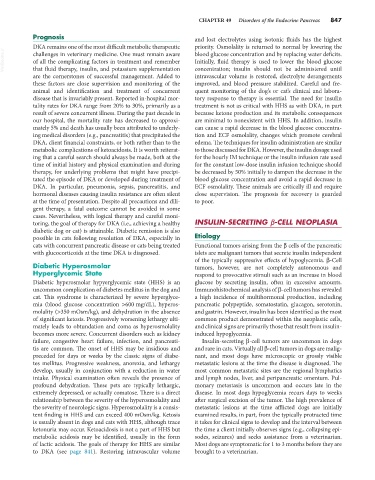Page 875 - Small Animal Internal Medicine, 6th Edition
P. 875
CHAPTER 49 Disorders of the Endocrine Pancreas 847
Prognosis and lost electrolytes using isotonic fluids has the highest
DKA remains one of the most difficult metabolic therapeutic priority. Osmolality is returned to normal by lowering the
VetBooks.ir challenges in veterinary medicine. One must remain aware blood glucose concentration and by replacing water deficits.
Initially, fluid therapy is used to lower the blood glucose
of all the complicating factors in treatment and remember
that fluid therapy, insulin, and potassium supplementation
intravascular volume is restored, electrolyte derangements
are the cornerstones of successful management. Added to concentration; insulin should not be administered until
these factors are close supervision and monitoring of the improved, and blood pressure stabilized. Careful and fre-
animal and identification and treatment of concurrent quent monitoring of the dog’s or cat’s clinical and labora-
disease that is invariably present. Reported in-hospital mor- tory response to therapy is essential. The need for insulin
tality rates for DKA range from 20% to 30%, primarily as a treatment is not as critical with HHS as with DKA, in part
result of severe concurrent illness. During the past decade in because ketone production and its metabolic consequences
our hospital, the mortality rate has decreased to approxi- are minimal to nonexistent with HHS. In addition, insulin
mately 5% and death has usually been attributed to underly- can cause a rapid decrease in the blood glucose concentra-
ing medical disorders (e.g., pancreatitis) that precipitated the tion and ECF osmolality, changes which promote cerebral
DKA, client financial constraints, or both rather than to the edema. The techniques for insulin administration are similar
metabolic complications of ketoacidosis. It is worth reiterat- to those discussed for DKA. However, the insulin dosage used
ing that a careful search should always be made, both at the for the hourly IM technique or the insulin infusion rate used
time of initial history and physical examination and during for the constant low-dose insulin infusion technique should
therapy, for underlying problems that might have precipi- be decreased by 50% initially to dampen the decrease in the
tated the episode of DKA or developed during treatment of blood glucose concentration and avoid a rapid decrease in
DKA. In particular, pneumonia, sepsis, pancreatitis, and ECF osmolality. These animals are critically ill and require
hormonal diseases causing insulin resistance are often silent close supervision. The prognosis for recovery is guarded
at the time of presentation. Despite all precautions and dili- to poor.
gent therapy, a fatal outcome cannot be avoided in some
cases. Nevertheless, with logical therapy and careful moni-
toring, the goal of therapy for DKA (i.e., achieving a healthy INSULIN-SECRETING β-CELL NEOPLASIA
diabetic dog or cat) is attainable. Diabetic remission is also
possible in cats following resolution of DKA, especially in Etiology
cats with concurrent pancreatic disease or cats being treated Functional tumors arising from the β cells of the pancreatic
with glucocorticoids at the time DKA is diagnosed. islets are malignant tumors that secrete insulin independent
of the typically suppressive effects of hypoglycemia. β-Cell
Diabetic Hyperosmolar tumors, however, are not completely autonomous and
Hyperglycemic State respond to provocative stimuli such as an increase in blood
Diabetic hyperosmolar hypyerglycemic state (HHS) is an glucose by secreting insulin, often in excessive amounts.
uncommon complication of diabetes mellitus in the dog and Immunohistochemical analysis of β-cell tumors has revealed
cat. This syndrome is characterized by severe hyperglyce- a high incidence of multihormonal production, including
mia (blood glucose concentration >600 mg/dL), hyperos- pancreatic polypeptide, somatostatin, glucagon, serotonin,
molality (>350 mOsm/kg), and dehydration in the absence and gastrin. However, insulin has been identified as the most
of significant ketosis. Progressively worsening lethargy ulti- common product demonstrated within the neoplastic cells,
mately leads to obtundation and coma as hyperosmolality and clinical signs are primarily those that result from insulin-
becomes more severe. Concurrent disorders such as kidney induced hypoglycemia.
failure, congestive heart failure, infection, and pancreati- Insulin-secreting β-cell tumors are uncommon in dogs
tis are common. The onset of HHS may be insidious and and rare in cats. Virtually all β-cell tumors in dogs are malig-
preceded for days or weeks by the classic signs of diabe- nant, and most dogs have microscopic or grossly visible
tes mellitus. Progressive weakness, anorexia, and lethargy metastatic lesions at the time the disease is diagnosed. The
develop, usually in conjunction with a reduction in water most common metastatic sites are the regional lymphatics
intake. Physical examination often reveals the presence of and lymph nodes, liver, and peripancreatic omentum. Pul-
profound dehydration. These pets are typically lethargic, monary metastasis is uncommon and occurs late in the
extremely depressed, or actually comatose. There is a direct disease. In most dogs hypoglycemia recurs days to weeks
relationship between the severity of the hyperosmolality and after surgical excision of the tumor. The high prevalence of
the severity of neurologic signs. Hyperosmolality is a consis- metastatic lesions at the time afflicted dogs are initially
tent finding in HHS and can exceed 400 mOsm/kg. Ketosis examined results, in part, from the typically protracted time
is usually absent in dogs and cats with HHS, although trace it takes for clinical signs to develop and the interval between
ketonuria may occur. Ketoacidosis is not a part of HHS but the time a client initially observes signs (e.g., collapsing epi-
metabolic acidosis may be identified, usually in the form sodes, seizures) and seeks assistance from a veterinarian.
of lactic acidosis. The goals of therapy for HHS are similar Most dogs are symptomatic for 1 to 3 months before they are
to DKA (see page 841). Restoring intravascular volume brought to a veterinarian.

